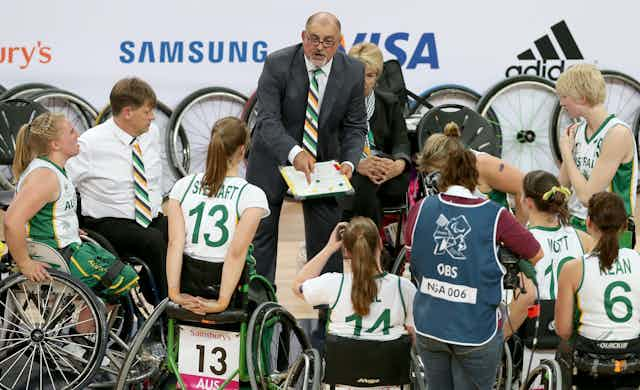The 2016 Rio Paralympics gives sports fans the opportunity to watch some of the world’s greatest athletes push the limits of human performance. Our Paralympians will be looking to emulate the success of the London 2012 games, where Australia finished fifth on the medal tally.
Behind our sporting stars is usually a great coach. They are often former athletes, who see coaching as a natural progression after retiring. Others begin at the grassroots level, learning their craft by attending coaching courses and from more experienced coaches as they move up the ranks.
Coaches must have expert knowledge about the skills, tactics, and physical training associated with their sport. These areas are typically the focus of coaching textbooks and manuals.
Coaches must also be competent teachers, and there are some important lessons they can learn from classroom teachers to get the best performance from their athletes.
From classroom to locker room
Some formal coaching courses contain small units on teaching skills, but coaches mostly learn in informal ways. This may be through practical experience, or with the help of a mentor.
But ineffective teaching practices can be passed on if the wrong models are observed. Many athletes would relate to the experience of having an “old-school” coach prescribing endless laps while screaming and taunting, believing it to be an effective form of discipline because it was the norm “back in my day”.
A similar phenomenon is observed in the field of teaching. In the 1990s, American psychologist Jerome Bruner introduced the idea of “folk pedagogies”: personal beliefs or intuition about the “right way” to teach. Folk pedagogies are often valued more highly than evidence suggesting that another approach is more effective.
While coaching is a mix of both art and science, coaches should consider the impact of the strategies they select in their particular context. Considering one’s impact – not simply practising the way someone else does, or because of a gut feeling – is at the heart of effective teaching.
In education, John Hattie demonstrated that nearly everything works for advancing student achievement, but some interventions work better than others.
A similar argument could be made for coaching, especially in youth sport where athletes improve by default as they physically mature. If every coaching strategy is assumed to work, coaches should instead focus their efforts on what works best to achieve maximum impact.
With this in mind, I set out to collect evidence (in the form of meta-analyses, arguably a more reliable form of evidence than single studies) on factors that influence sports performance. Sifting past studies on physical training, I wanted to know what teaching-related practices could be applied across a range of sports.
What influences sports performance?
An athlete’s improvement is enhanced by setting goals that are specific, appropriately challenging for their current abilities, and focused on attaining mastery rather than avoiding failure.
Coaches who can foster a sense of belief in their athletes’ own abilities, and the ability of their teams (known as collective self-efficacy), may be particularly well placed to improve performance.
Team cohesion has a large positive effect on sports performance, but is more effective when coaches encourage teams to rally around a shared goal rather than simply form social bonds.
Coaches should also be aware of their influence on an athlete’s mental state: anger, fatigue, confusion, and tension are all associated with negative performance outcomes.
More closely related to the traditional notion of teaching are findings on practice and learning strategies. It is more beneficial, for instance, to space skill training out over smaller practice sessions (distributed practice) rather than one larger session (massed practice).
The popular folklore of needing to practice something for 10,000 hours to become a master is a point of contention among experts. But the author of the original paper from which this claim was extrapolated, Anders Ericsson, now emphasises the importance of mindful, self-evaluative practice instead of simply accumulating hours via repetition.
While deliberate practice is associated with large improvements in sports skill learning, it explains just 18% of the variance in performance between athletes. And deliberate practice requires coaches who are deliberate in their interventions – watching, tweaking, reinforcing, teaching new strategies, and making practice enjoyable and sustaining.
While the research provides some reliable initial evidence on what works best for sports coaching, more is needed.
We know relatively little, for instance, about how to help athletes better receive and use feedback. Feedback is among the most powerful influences on student achievement, so knowing how to best use feedback with athletes appears important.
Until more evidence is collected, perhaps the best advice from education is for coaches to walk into every session and “know thy impact”. This requires coaches to be conscious of the methods they select, and to continually seek evidence to evaluate the effectiveness of each approach.
With this, our athletes – whether they’re Paralympians, Olympians, or under-10s – are more likely to succeed.

